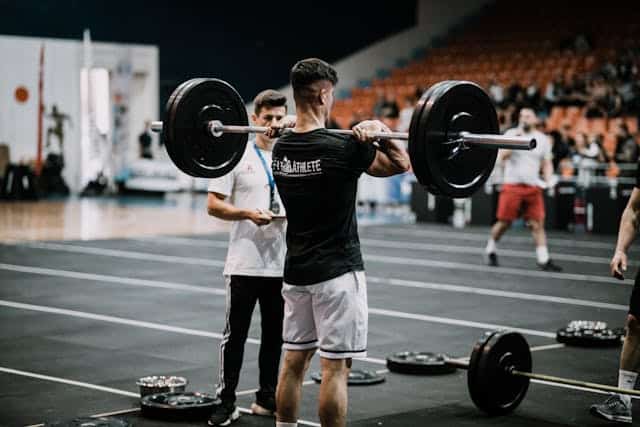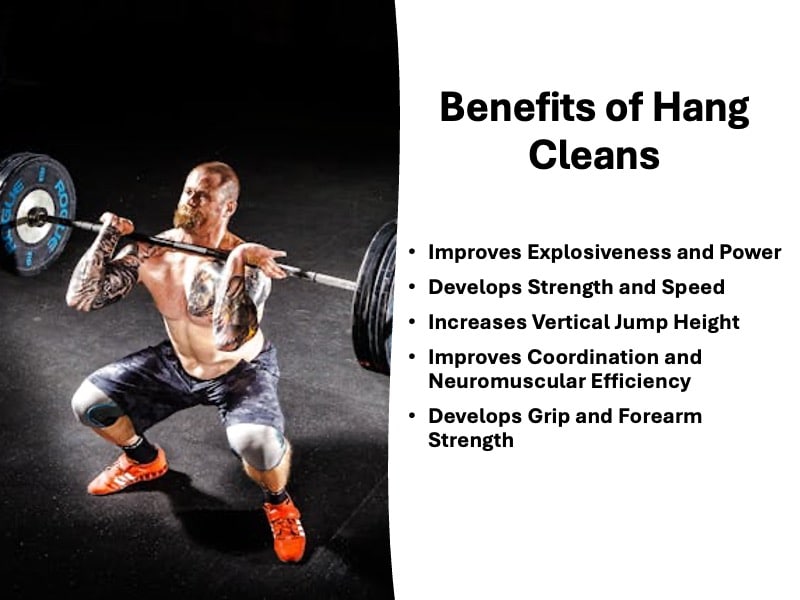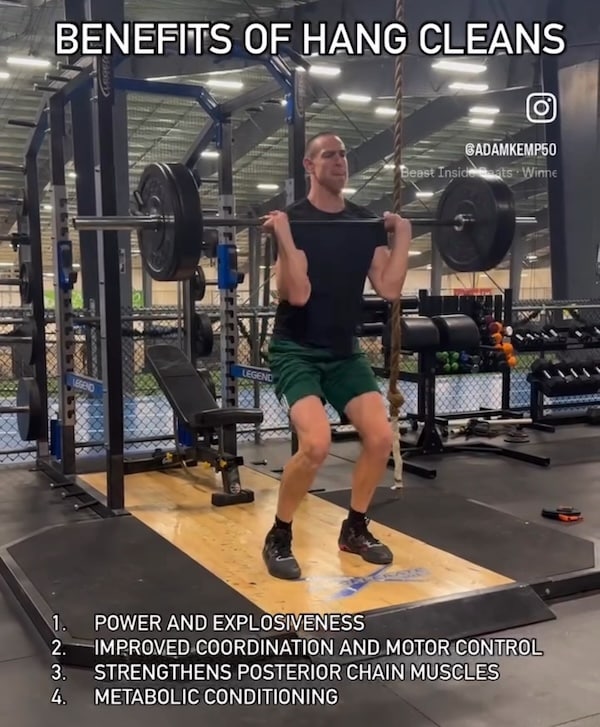Hang Cleans: Benefits, Muscles Worked, and How to Do Them
I absolutely love hang cleans and firmly believe that every athlete should learn how to do them properly.
They are one of the best exercises for developing explosive power, full-body strength, and athleticism—qualities that translate directly into better sprint speed, higher jumps, and overall improved performance.
When I was jumping my highest in college, my one-rep max for the hang clean was 255 lbs, about 15 pounds over my body weight at the time.
That was the most athletic and explosive I’ve ever been.
The carryover to my game was undeniable—my ability to jump, sprint, and change direction felt effortless.
I’ve also experienced the other side of hang cleans—doing them in high-rep, CrossFit-style workouts, which, in hindsight, wasn’t the smartest approach.
While I survived those brutal sessions, I later learned how to program hang cleans correctly to maximize their benefits without unnecessary fatigue or injury risk.
When used correctly, hang cleans enhance power, strength, and neuromuscular coordination, making them one of the most valuable exercises for serious athletes.
If you want to improve your athletic performance, increase explosive power, and build total-body strength, hang cleans should be a key part of your training program.
Keep reading to learn why hang cleans are so effective, what muscles they work, how to do them properly, and the best ways to progress safely and efficiently.
What Muscles Do Hang Cleans Work?

As a compound movement, the hang clean demands full-body activation, making it a staple in athletic training programs focused on power development.
A study published in the Journal of Sports Science and Medicine (2023) highlighted that the hang power clean activates the vastus lateralis, gluteus maximus, and erector spinae significantly across different levels of weightlifting expertise, demonstrating its effectiveness as a full-body explosive lift.
This dynamic lift primarily targets the posterior chain—a group of muscles essential for sprinting, jumping, and overall athleticism—while also engaging the upper body and core for stability and control.
Hang cleans are one of the most powerful posterior chain exercises as they engage multiple muscle groups simultaneously to develop strength, explosiveness, and coordination.
By efficiently recruiting both fast-twitch and stabilizing muscle fibers, hang cleans contribute to enhanced neuromuscular coordination, increased force production, and improved movement efficiency.
Key muscles hang cleans work include:
Lower Body Muscles
- Quadriceps: Responsible for knee extension during the explosive pull.
- Hamstrings: Aid in hip extension and stabilization during the lift.
- Glutes: Generate power for the explosive drive.
- Calves: Assist in force production and stability during the movement.
Upper Body Muscles
- Trapezius: Plays a crucial role in the shrugging phase of the clean.
- Deltoids: Assist in pulling the bar upward and stabilizing the shoulders.
- Forearms and Grip Muscles: Essential for maintaining control of the barbell.
Core and Stabilizing Muscles
- Erector Spinae: Helps maintain posture and protect the spine.
- Abdominals & Obliques: Engage to stabilize the torso and transfer power efficiently.
Benefits of Hang Cleans

Hang cleans are one of the most effective exercises for developing power, strength, speed, and neuromuscular coordination.
This Olympic weightlifting movement trains explosive force production, which is essential for athletes in sports requiring rapid acceleration, jumping, or changes in direction.
Beyond athletic applications, hang cleans develop functional movement patterns, build full-body strength, and develop grip endurance.
Each phase of the lift—initial pull, triple extension, and receiving position—engages multiple muscle groups and requires high levels of coordination, making it one of the most comprehensive lifts for building total-body athleticism.
Improves Explosiveness and Power
Explosiveness is defined as the ability to generate force rapidly, a crucial component of sprinting, jumping, and sports that require quick, powerful movements.
The hang clean specifically improves rate-of-force development (RFD)—the speed at which force is generated in a movement.
A study in the International Journal of Sports Physiology and Performance (2020) found that power output during hang power cleans peaked when athletes lifted at 80% of their one-repetition maximum (1RM).
This suggests that submaximal loads are optimal for maximizing explosive force, as they allow the lifter to generate the highest possible velocity while maintaining technical efficiency.
Hang cleans achieve this through triple extension—simultaneous extension of the ankles, knees, and hips.
This movement pattern mimics the mechanics of sprinting, jumping, and other dynamic athletic actions.
Studies have found a direct correlation between Olympic weightlifting exercises like hang cleans and improvements in peak power output, making them a foundational tool in many strength and conditioning programs.
Develops Strength and Speed
Strength and speed are closely linked in athletic performance, and hang cleans train both simultaneously.
Olympic lifts like the hang clean are particularly valuable because they develop dynamic strength, which refers to force generation during rapid movements rather than static positions.
A 2024 study on female handball players (International Journal of Sports Physiology and Performance) compared training at 90% of 1RM to 50% of 1RM for hang power cleans.
Both groups improved sprint performance and 1RM strength, but the high-intensity group (90% 1RM) had greater gains in sprint speed and squat strength.
This indicates that heavy resistance training with hang cleans is more effective for improving maximum dynamic strength, which translates directly to faster acceleration and increased speed on the field or court.
Moreover, hang cleans help develop high-velocity strength, which is essential for improving first-step quickness and short-distance acceleration.
Studies have shown that athletes who excel in the hang clean also perform better in 10-meter sprints and agility drills, demonstrating why it is one of the best exercises for basketball players and other athletes with similar physical demands.
Increases Vertical Jump Height
Explosive lower-body power is a key determinant of vertical jump ability.
The ability to rapidly recruit fast-twitch muscle fibers in the quadriceps, hamstrings, and glutes is essential for generating upward force.
A Biology of Sport (2016) study investigated the effects of six weeks of hang clean training on NCAA Division I female athletes and found a significant increase in vertical jump height.
The improvement was attributed to the enhanced neuromuscular coordination and force production trained through the hang clean.
The primary reason hang cleans improve vertical jump height is their emphasis on peak power output at hip extension.
Research has shown that the hip drive during a properly executed hang clean closely replicates the force vectors involved in jumping, making it a highly effective exercise for improving explosive leaping ability.
Furthermore, training with Olympic lifts like the hang clean has been found to activate the stretch-shortening cycle (SSC) more effectively than traditional resistance exercises.
The SSC improves the ability of muscles to store and release elastic energy, leading to greater jump height and efficiency in athletic movements.
Improves Coordination and Neuromuscular Efficiency
Hang cleans are a highly technical lift, requiring precise timing and coordination between multiple muscle groups.
Each repetition trains the neuromuscular system to fire muscle fibers more efficiently, improving overall movement mechanics.
A study in the Journal of Strength and Conditioning Research (2018) highlighted that hang cleans require significant joint-specific coordination, particularly at the hips, knees, and ankles.
The movement teaches athletes how to efficiently transfer force from the ground up, which is essential in sprinting, jumping, and change-of-direction sports.
Additionally, the fast transition from the pull to the catch forces the body to react quickly, training motor control and proprioception.
This improves an athlete’s ability to react and move efficiently in dynamic sports settings.
Neuromuscular adaptations from hang cleans also reduce injury risk by reinforcing proper landing mechanics.
Athletes who train with Olympic lifts have been shown to exhibit better landing posture and force absorption, reducing stress on the knees and lower back during high-impact movements.
Develops Grip and Forearm Strength
Since the barbell must be held securely from the start of the lift through the catch phase, hang cleans significantly increase grip strength and forearm endurance.
Grip strength is often an overlooked component of athletic performance, but it plays a crucial role in weightlifting, wrestling, rock climbing, and any sport that requires strong hand control.
During a hang clean, the forearm flexors, wrist stabilizers, and hand muscles must maintain a firm grip on the barbell while enduring high levels of tension and rapid force changes.
This builds a stronger, more resilient grip, which translates to improvements in deadlifts, pull-ups, and other pulling movements.
Moreover, research has found that grip strength is positively correlated with overall upper-body strength.
Stronger grip muscles also improve performance in pressing movements and reduce the risk of forearm, wrist, and elbow injuries.
Another key benefit of hang cleans is their effect on wrist mobility and resilience. The catch phase of the clean requires rapid wrist extension, which strengthens connective tissues and improves wrist flexibility over time.
This is particularly beneficial for athletes in contact sports who need strong, stable wrists to absorb impact forces.
How to Do Hang Cleans Safely
Executing hang cleans with proper form is essential for maximizing benefits while minimizing injury risk. Follow these step-by-step instructions to do hang cleans safely:
Step 1: Setup
- Start with your feet hip-width apart and the barbell in your hands at the mid-thigh position.
- Use a hook grip (thumb wrapped around the bar, with fingers gripping over the thumb) for better control.
- Maintain a neutral spine, slightly bent knees, and a tall chest.
Step 2: The Explosive Pull
- Initiate the movement by forcefully extending your hips, knees, and ankles in a powerful triple extension.
- As the bar rises, shrug your shoulders and pull yourself under the bar.
Step 3: The Catch
- Rotate your elbows quickly under the bar as it reaches chest level.
- Catch the bar in the front rack position, with elbows high and bar resting on the shoulders.
- Absorb the force by bending your knees into a quarter-squat stance.
Step 4: Stand Up
- Once the bar is secured, stand up fully to complete the lift.
- Reset and repeat for the desired number of repetitions.
How to Progress with Hang Cleans
Mastering hang cleans requires a balance of technical proficiency, strength development, and progressive overload.
Since this movement is both highly explosive and mechanically complex, advancing with hang cleans involves more than just increasing weight—it requires refining technique, optimizing load selection, and incorporating variations that reinforce power, coordination, and mobility.
Progressing safely and effectively means focusing on technical drills, submaximal loading strategies, and strength-building exercises that complement the movement.
Whether you’re a beginner learning the fundamentals or an experienced lifter looking to maximize performance, a structured approach will ensure steady improvements while minimizing the risk of injury.
Here’s how to systematically progress with hang cleans and continue developing explosive strength over time.
Start with Technique Work
Before increasing weight, focus on mastering the movement with light loads. Drills like the hang high pull and front squat can help refine technique.
Use Submaximal Loads for Power Development
Since research suggests that training at 80% of 1RM is optimal for peak power output, working within this range can maximize explosiveness while minimizing fatigue.
Increase Load Gradually
Progressively overload by increasing weight in small increments (2.5–5% per week). Avoid jumping to heavier weights too quickly, as it can compromise form.
Incorporate Plyometric Training
Pairing hang cleans with plyometrics (e.g., box jumps, broad jumps) can further improve explosive strength through post-activation potentiation, as suggested by the Journal of Strength and Conditioning Research (2011).
Train Variations for Different Benefits
- Hang Power Clean – Emphasizes bar speed and catching the bar high.
- Hang Squat Clean – Focuses on maximal strength and full squat mobility.
- Hang Clean Pulls – Develops pulling strength and technique.
Monitor Fatigue and Recovery
Since hang cleans are a high-intensity movement, ensure proper recovery by allowing 48-72 hours between heavy sessions.
Using contrast training methods, like pairing hang cleans with lighter explosive movements, can also help improve recovery.
Barbell vs. Dumbbell vs. Kettlebell Hang Clean: Which Is Best?
Hang cleans are a highly effective exercise for developing power, strength, and coordination, but the choice of equipment—barbell, dumbbells, or kettlebells—affects how the movement is performed and the benefits gained. Each variation has advantages and is suited to different training goals.
Barbell Hang Clean
The barbell hang clean is the standard for maximal strength and power development. It allows for heavier loading, making it the best choice for athletes focused on explosiveness.
Pros
- Supports progressive overload for maximum power development
- Trains triple extension, improving sprinting and jumping ability
- Essential for Olympic weightlifting and high-performance training
Cons
- High technical demand, requiring mobility and coordination
- Can stress the wrists and elbows if performed incorrectly
- Less emphasis on unilateral strength and stability
Best for: Strength athletes, Olympic lifters, and those aiming for maximum power and explosiveness.
Dumbbell Hang Clean
The dumbbell hang clean is more accessible and versatile, making it a great choice for beginners and functional strength training.
Pros
- Easier to learn and perform with less wrist stress
- Allows for greater range of motion and movement freedom
- Improves unilateral strength and balance
Cons
- Lower loading capacity compared to a barbell
- Requires more coordination to control two independent weights
- Less direct carryover to Olympic lifts
Best for: Beginners, athletes needing unilateral strength, and those with limited equipment.
Kettlebell Hang Clean
The kettlebell hang clean emphasizes grip strength, core stability, and fluid movement, making it ideal for functional fitness.
Pros
- Develops wrist and grip strength with its offset center of gravity
- Encourages dynamic movement and core engagement
- Easier on the joints compared to barbell variations
Cons
- Limited maximum loading, making it less effective for pure strength gains
- Technique requires practice to avoid wrist impact during the catch
- Less direct carryover to barbell weightlifting movements
Best for: Functional fitness, grip and core strength, and high-rep conditioning.
Which Hang Clean Variation Should You Choose?
- For maximum strength and explosiveness: Barbell hang clean
- For versatility, unilateral strength, and accessibility: Dumbbell hang clean
- For grip endurance, mobility, and dynamic training: Kettlebell hang clean
The best choice depends on your goals and experience level, but all three variations can be effective when programmed correctly.
Final Thoughts: Are Hang Cleans a Good Exercise for You?
Hang cleans are one of the most effective posterior chain exercises for developing explosive power, strength, and athleticism.
Whether you’re an athlete looking to improve sprint speed and vertical jump height or a fitness enthusiast aiming to enhance overall strength and coordination, hang cleans offer full-body benefits that translate into better performance in a wide range of activities.
This movement trains triple extension, a key factor in sprinting, jumping, and rapid directional changes. It also improves neuromuscular efficiency, teaching the body to produce force quickly and efficiently.
Additionally, hang cleans help build grip strength, core stability, and postural control, making them an excellent exercise for both performance enhancement and injury prevention.
However, because of their technical nature, proper coaching and gradual progression are essential for maximizing results while avoiding injury.
Beginners should prioritize form, mobility, and technique drills before increasing weight, while advanced lifters can refine their performance through optimized loading strategies and complementary strength exercises.
If your goal is to build explosive strength, full-body coordination, and functional athleticism, incorporating hang cleans into your routine is a smart and effective choice.



